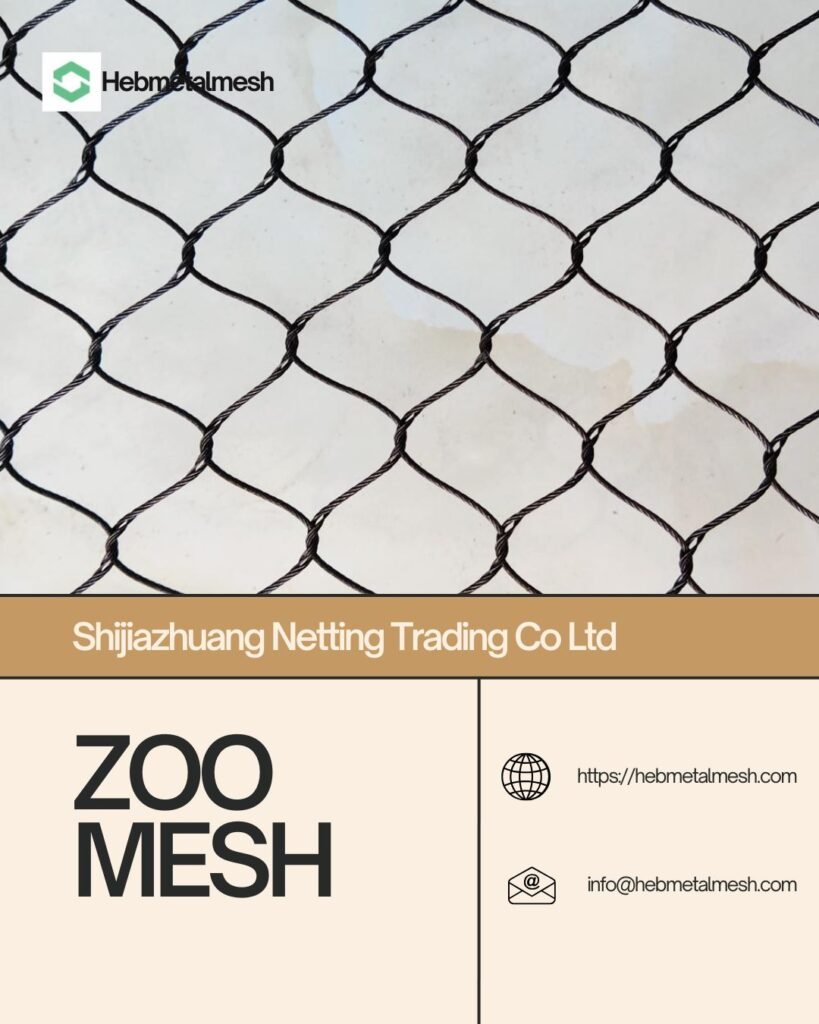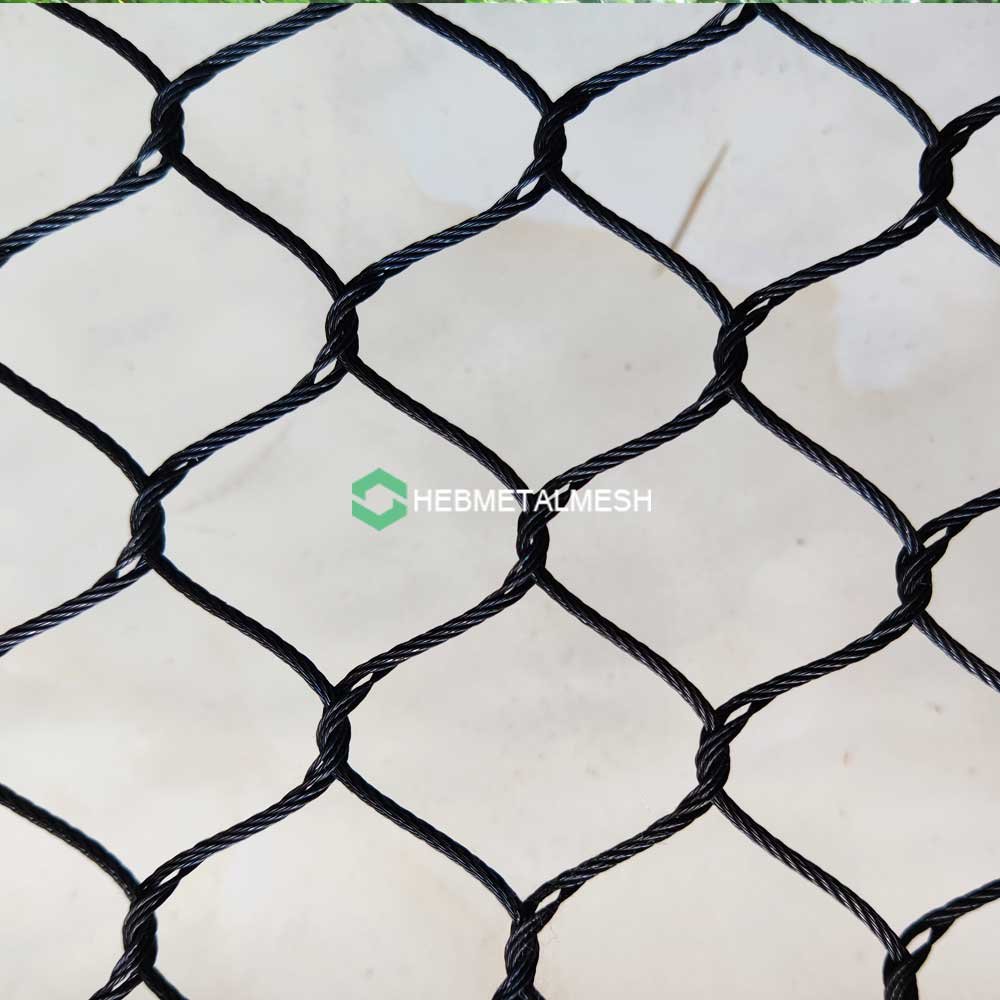Protect Your Animals with Stainless Steel 304 Fencing
Whether you’re a farmer safeguarding livestock, a zookeeper managing exotic species, or a wildlife reserve manager balancing conservation with safety, animal fencing is a critical investment. Traditional materials like wood, plastic, or galvanized wire often fail under pressure from weather, corrosion, or determined animals. Our stainless steel 304 netting for animal enclosures solves these problems with unmatched durability, flexibility, and safety.
In this guide, we’ll cover:
- Why stainless steel 304 outperforms other materials
- How customization reduces costs and waste
- Real-world applications for farms, zoos, and parks
- Answers to the most common buyer questions
- How to order fencing tailored to your needs
Specifications of Animal Fencing Products
Product Name: Animal Fencing
Material: Stainless Steel Wire Rope 304/316
Roll Size: Max 30′ x 60′
Customized: Available with same cost.
| Item ID | Animal Fencing Details | Material |
|---|---|---|
| HM1220 | 3/4″ x 3/4″ x 3/64″ | SS304/316 |
| HM1225 | 1″ x 1″ x 3/64″ | SS304/316 |
| HM1238 | 1.5″ x 1.5″ x 3/64″ | SS304/316 |
| HM1250 | 2″ x 2″ x 3/64″ | SS304/316 |
| HM1276 | 3″ x 3″ x 3/64″ | SS304/316 |
| HM12102 | 4″ x 4″ x 3/64″ | SS304/316 |
| HM1625 | 1″ x 1″ x 1/16″ | SS304/316 |
| HM1638 | 1.5″ x 1.5″ x 1/16″ | SS304/316 |
| HM1650 | 2″ x 2″ x 1/16″ | SS304/316 |
| HM1676 | 3″ x 3″ x 1/16″ | SS304/316 |
| HM16102 | 4″ x 4″ x 1/16″ | SS304/316 |
| HM2038 | 1.5″ x 1.5″ x 5/64″ | SS304/316 |
| HM2050 | 2″ x 2″ x 5/64″ | SS304/316 |
| HM2076 | 3″ x 3″ x 5/64″ | SS304/316 |
| HM20102 | 4″ x 4″ x 5/64″ | SS304/316 |
| HM2438 | 1.5″ x 1.5″ x 3/32″ | SS304/316 |
| HM2450 | 2″ x 2″ x 3/32″ | SS304/316 |
| HM2476 | 3″ x 3″ x 3/32″ | SS304/316 |
| HM24102 | 4″ x 4″ x 3/32″ | SS304/316 |
| HM3250 | 2″ x 2″ x 1/8″ | SS304/316 |
| HM3276 | 3″ x 3″ x 1/8″ | SS304/316 |
| HM32102 | 4″ x 4″ x 1/8″ | SS304/316 |
Why Stainless Steel 304 Is the Gold Standard for Animal Fencing

Not all metals are created equal. Stainless steel 304 is a premium alloy containing 18% chromium and 8% nickel, making it:
- Rust-proof: Resists corrosion from rain, humidity, saltwater, and chemicals.
- Non-reactive: Safe for animals—no toxic coatings or sharp edges.
- Extremely strong: Withstands impacts from large animals or debris.
- Low maintenance: No painting, sealing, or frequent repairs.
Compare to Alternatives:
| Material | Lifespan | Maintenance | Animal Safety |
|---|---|---|---|
| Galvanized Steel | 5–10 years | High | Moderate |
| PVC-Coated Wire | 3–7 years | Medium | High |
| Stainless Steel 304 | 20+ years | Low | High |
Customizable Solutions for Every Application
Our animal fencing isn’t a one-size-fits-all product. We tailor rolls to your exact specifications to reduce costs and waste.
Standard & Custom Roll Sizes
- Standard: 30’ x 60’ (ideal for small farms or enclosures).
- Custom: Specify length, width, or mesh density to match your project.
Example: A wildlife park needed fencing for a 2-acre predator enclosure. By ordering custom-sized rolls, they saved $1,200 in material waste vs. standard sizes.
Color Options for Every Environment
Choose between two finishes:
- Natural (Silver): Blends into rural landscapes or natural habitats.
- Black Oxide: Provides a sleek, modern look for zoos or urban parks.
Who Uses Our Animal Fencing Netting?
1. Farmers & Ranchers
- Secure Livestock: Prevent escapes for cattle, sheep, goats, or poultry.
- Crop Protection: Keep deer, rabbits, and rodents away from fields.
- Durability: Survives harsh winters, storms, and UV exposure.
2. Zoos & Animal Sanctuaries
- Safety First: Contain big cats, primates, or birds without risky gaps.
- Visitor Visibility: Thin, strong mesh allows clear viewing.
- Aesthetic Design: Black oxide finish complements modern exhibits.
3. Wildlife Parks & Conservation Areas
- Humane Barriers: Prevent human-wildlife conflict without harming animals.
- Eco-Friendly: Stainless steel doesn’t leach chemicals into soil or water.
Installation Tips for Long-Term Performance
Proper installation ensures your netting for animal enclosures lasts decades. Follow these steps:
- Prepare the Site: Clear debris, mark boundaries, and ensure posts are spaced 6–8 feet apart.
- Unroll & Secure: Attach the mesh to posts using stainless steel clips or hog rings.
- Tensioning: Use a come-along tool to eliminate sagging.
- Inspect Regularly: Check for loose fasteners or debris buildup every 3–6 months.
Pro Tip: For large projects, ask about our partner network of professional installers.
FAQs: What Buyers Want to Know
A: With proper installation, it resists corrosion for 20+ years, even in extreme conditions.
A: Absolutely. Stainless steel 304 is non-toxic, smooth-edged, and free of sharp points.
A: Yes! Custom sizing reduces costs by eliminating excess material. Share your requirements for a quote.
A: Use standard fencing tools. We provide guides, or our team can recommend professional installers.
A: Most orders ship in 3–5 business days. Custom sizes may take 7–10 days.
A: Email info@hebmetalmesh.com, or fill out our [Contact Form] for fast assistance. Bulk discounts available!
Cost Savings Over Time: A Smart Investment
While stainless steel 304 has a higher upfront cost than galvanized wire, it pays for itself over time:
| Expense | Galvanized Steel (10 Years) | Stainless Steel 304 (20+ Years) |
|---|---|---|
| Material | $2,000 | $3,500 |
| Labor/Repairs | $1,500 | $200 |
| Total | $3,500 | $3,700 |
You save $3,300+ over 20 years with stainless steel!
Sustainability & Animal Welfare
Our fencing isn’t just strong—it’s ethical:
- Non-Toxic: Safe for animals that chew or rub against the mesh.
- Eco-Friendly Production: Made with 70% recycled materials.
- Zero Waste: Custom sizing ensures no excess material goes to landfills.
Why Customers Love Our Animal Fencing
- Cost-Effective: Custom sizes = lower upfront costs.
- Low Maintenance: No painting or frequent repairs.
- Humane Design: Safe for animals and handlers.
Ready to Order?
Protect your animals with fencing built to last. Contact Us today for:
- Instant pricing
- Custom size quotes
- Expert advice
